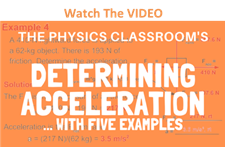How To Find Acceleration From Force And Mass
Finding Acceleration
The procedure of determining the acceleration of an object demands that the mass and the cyberspace strength are known. If mass (chiliad) and cyberspace force (Finternet) are known, then the acceleration is determined by use of the equation. Thus, the job involves using the higher up equations, the given information, and your understanding of Newton's laws to determine the dispatch. To gain a experience for how this method is applied, try the following exercise problems. Once you have solved the bug, click the button to check your answers. An applied forcefulness of 50 N is used to accelerate an object to the right across a frictional surface. The object encounters ten N of friction. Use the diagram to determine the normal force, the internet force, the mass, and the dispatch of the object. (Neglect air resistance.) An applied force of 20 N is used to accelerate an object to the right across a frictional surface. The object encounters x N of friction. Apply the diagram to determine the normal force, the internet strength, the coefficient of friction (μ) between the object and the surface, the mass, and the acceleration of the object. (Neglect air resistance.) A v-kg object is sliding to the right and encountering a friction forcefulness that slows it downward. The coefficient of friction (μ) between the object and the surface is 0.1. Determine the force of gravity, the normal force, the force of friction, the net strength, and the acceleration. (Neglect air resistance.) 1. Edwardo applies a 4.25-N rightward forcefulness to a 0.765-kg volume to accelerate it across a tabletop. The coefficient of friction betwixt the volume and the tabletop is 0.410. Make up one's mind the acceleration of the book. 2. In a physics lab, Kate and Rob utilise a hanging mass and pulley system to exert a 2.45 Due north rightward force on a 0.500-kg cart to accelerate it across a depression-friction track. If the total resistance force to the motion of the cart is 0.72 N, then what is the cart's dispatch? As learned earlier in Lesson 3 (as well as in Lesson 2), the net force is the vector sum of all the individual forces. In Lesson ii, we learned how to decide the net force if the magnitudes of all the individual forces are known. In this lesson, we volition larn how to determine the acceleration of an object if the magnitudes of all the individual forces are known. The 3 major equations that will be useful are the equation for net force (Fnet = thousand•a), the equation for gravitational force (Fgrav = k•g), and the equation for frictional force (Ffrict = μ • Fnorm).
As learned earlier in Lesson 3 (as well as in Lesson 2), the net force is the vector sum of all the individual forces. In Lesson ii, we learned how to decide the net force if the magnitudes of all the individual forces are known. In this lesson, we volition larn how to determine the acceleration of an object if the magnitudes of all the individual forces are known. The 3 major equations that will be useful are the equation for net force (Fnet = thousand•a), the equation for gravitational force (Fgrav = k•g), and the equation for frictional force (Ffrict = μ • Fnorm). Your Turn to Exercise
Exercise #1
Practise #2
Practice #iii
A couple more do bug are provided below. You lot should make an effort to solve as many problems equally you can without the assistance of notes, solutions, teachers, and other students. Commit yourself to individually solving the problems. In the meantime, an important caution is worth mentioning:
Avoid forcing a problem into the class of a previously solved problem. Problems in physics will seldom look the same. Instead of solving problems by rote or past mimicry of a previously solved problem, use your conceptual agreement of Newton's laws to work towards solutions to issues. Use your understanding of weight and mass to find the one thousand or the Fgrav in a trouble. Use your conceptual understanding of cyberspace forcefulness (vector sum of all the forces) to find the value of Fnet or the value of an individual force. Do not divorce the solving of physics problems from your agreement of physics concepts. If yous are unable to solve physics bug like those to a higher place, it is does not necessarily mean that you lot are having math difficulties. Information technology is likely that you are having a physics concepts difficulty.
We Would Like to Propose ...
 Sometimes it isn't plenty to just read about it. You have to interact with it! And that's exactly what yous do when you use 1 of The Physics Classroom's Interactives. We would like to suggest that you combine the reading of this page with the utilize of our Force Interactive. You tin can discover it in the Physics Interactives department of our website. The Force Interactive allows a learner to explore the effect of variations in practical strength, net forcefulness, mass, and friction upon the dispatch of an object.
Sometimes it isn't plenty to just read about it. You have to interact with it! And that's exactly what yous do when you use 1 of The Physics Classroom's Interactives. We would like to suggest that you combine the reading of this page with the utilize of our Force Interactive. You tin can discover it in the Physics Interactives department of our website. The Force Interactive allows a learner to explore the effect of variations in practical strength, net forcefulness, mass, and friction upon the dispatch of an object. Check Your Understanding
Source: https://www.physicsclassroom.com/class/newtlaws/Lesson-3/Finding-Acceleration
Posted by: santanafaccons.blogspot.com


0 Response to "How To Find Acceleration From Force And Mass"
Post a Comment